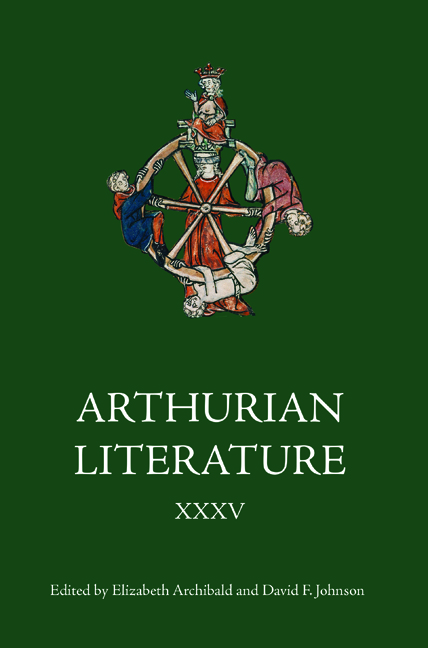Book contents
- Frontmatter
- Contents
- List of Illustrations
- General Editors’ Foreword
- List of Contributors
- I Arthurian Swords I: Gawain’s Sword and the Legend of Weland the Smith
- II Rex rebellis et vir pacificus: Civil War and Ecclesiastical Peacekeeping in the Vita Gildae of Caradog of Llancarfan
- III Once and Future History: Textual Borrowing in an Account of the First War of Scottish Independence
- IV ‘Me rewes sore’: Women’s Friendship, Affect and Loyalty in Ywain and Gawain
- V The Sacred and the Secular: Alchemical Transformation in The Turke and Sir Gawain
- VI ‘The native place of that great Arthur’: Foreignness and Nativity in Sixteenth-Century Defences of Arthur
- VII John Steinbeck’s ‘Wonder-Words’
- VIII The Once and Future King of Atlantis: The Arthurian Figure in Geoff Johns’s Aquaman: Death of a King
- IX Arthur and/or the Grail
- Miscellaneous Endmatter
III - Once and Future History: Textual Borrowing in an Account of the First War of Scottish Independence
Published online by Cambridge University Press: 11 September 2020
- Frontmatter
- Contents
- List of Illustrations
- General Editors’ Foreword
- List of Contributors
- I Arthurian Swords I: Gawain’s Sword and the Legend of Weland the Smith
- II Rex rebellis et vir pacificus: Civil War and Ecclesiastical Peacekeeping in the Vita Gildae of Caradog of Llancarfan
- III Once and Future History: Textual Borrowing in an Account of the First War of Scottish Independence
- IV ‘Me rewes sore’: Women’s Friendship, Affect and Loyalty in Ywain and Gawain
- V The Sacred and the Secular: Alchemical Transformation in The Turke and Sir Gawain
- VI ‘The native place of that great Arthur’: Foreignness and Nativity in Sixteenth-Century Defences of Arthur
- VII John Steinbeck’s ‘Wonder-Words’
- VIII The Once and Future King of Atlantis: The Arthurian Figure in Geoff Johns’s Aquaman: Death of a King
- IX Arthur and/or the Grail
- Miscellaneous Endmatter
Summary
In 1946, Laura Keeler discovered a textual borrowing in a fourteenth-century chronicle segment that has become a conversation piece for Arthurian scholars. The text, known today as the Annales Angliæ et Scotiæ, 1292–1300 (hereafter AAS), was written at the Benedictine abbey of St Albans and, as its name suggests, chronicles political developments in England and Scotland from 1292 to 1300. Keeler discovered that the anonymous monastic chronicler of AAS used the description of King Arthur's plenary court at Caerleon from the vulgate version (c.1137) of Geoffrey of Monmouth's Historia regum Britannie (HRB) as the textual template for his coverage of the marriage between Edward I of England (r. 1272–1307) and Princess Marguerite of France at Canterbury (10 September 1299). The chronicler retained much of HRB's original wording but changed the name of the king and some other details to reflect the contemporary circumstance. He does not mention Arthur in the segment, and there are no textual clues or marginalia hinting that his account was derivative.
This textual borrowing in AAS is intriguing for two reasons. First, the source for the borrowing was neither biblical nor classical, but relatively recent: Geoffrey of Monmouth's faux-antique and classicizing HRB. Second, the chronicle's protagonist, King Edward I, is known to have used Galfridian pseudo-history in the service of his imperialist agenda in Wales and Scotland. Edward also cultivated an Arthurian persona as part of his style of kingship. His ‘Arthurian enthusiasm’, as Roger Sherman Loomis has referred to it, makes the fittingness of HRB as a fount for borrowings apparent, but it also introduces a complication, namely whether the account, by its textual borrowing, alludes to an actual instance of Arthurian imitation orchestrated by Edward.
Keeler did not detect any further borrowings in AAS and regarded the seemingly isolated use of HRB as a sign that the monk lacked specific details about the wedding. Although the event had numerous witnesses, subsequent scholarship has embraced Keeler's explanation and added to it. . Loomis, for example, further speculated that the monk knew that the festivities included an Arthurian ludic component and consequently used HRB to fill out his entry. Loomis’ suggestion is now the standard explanation.
- Type
- Chapter
- Information
- Arthurian Literature XXXV , pp. 44 - 116Publisher: Boydell & BrewerPrint publication year: 2019



